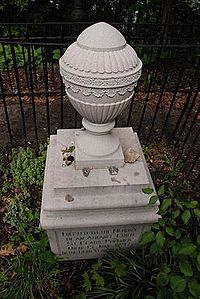Amiable Child Monument facts for kids
Quick facts for kids Amiable Child Monument |
|
|---|---|
 |
|
| Year | 1967 |
| Type | Granite |
| Location | New York, New York, United States |
The Amiable Child Monument is a special memorial in New York City's Riverside Park. You can find it near 122nd Street in the Morningside Heights area. This monument honors a young boy named St. Claire Pollock who passed away a long time ago.
Contents
What is the Amiable Child Monument?
The monument is a granite urn placed on a granite stand. It is surrounded by a decorative iron fence. One side of the monument has words carved into it. It says: "Erected to the Memory of an Amiable Child, St. Claire Pollock, Died 15 July 1797 in the Fifth Year of His Age." This means St. Claire Pollock died on July 15, 1797, when he was only four years old.
The monument was first put up by George Pollock, who was either the boy's father or his uncle. The area where it stands used to be a quiet countryside with homes. Over time, the monument has been replaced twice because the old ones wore out. The one you see today was placed there in 1967. It replaced an older marble marker from 1897. The monument is also located across the street from Grant's Tomb, a famous landmark.
A Place of Inspiration
For many years, the Amiable Child Monument has inspired people. In the late 1800s, when Morningside Heights was a popular spot, many famous people visited the nearby Claremont Inn. The monument became a place for people to visit and even write poems about.
One poet, Herman George Scheffauer, wrote a poem called "An Amiable Child." Another poet, Anna Markham, also wrote a poem with the same name. Her poem described the monument as a peaceful spot. The monument also inspired a novel by Irene Marcuse called Death of an Amiable Child.
A Unique Grave Site
The Amiable Child Monument is very special because it is thought to be the only private grave for one person on land owned by New York City.
At one point, there was a plan to move the grave. This was to make space for Grant's Tomb. However, many people in the city were against moving it. Because of their strong feelings, the city decided not to move the monument. This event made the monument even more well-known. It became a symbol of the kindness found in a big city.
Images for kids


